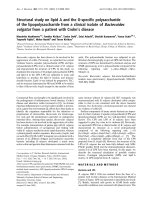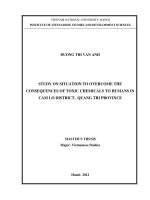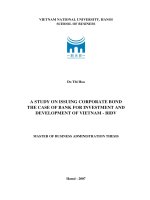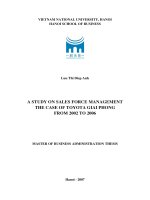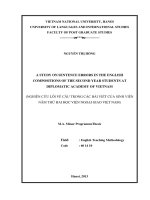Study on marketing behaviour of the cashew farmers of Tamil Nadu
Bạn đang xem bản rút gọn của tài liệu. Xem và tải ngay bản đầy đủ của tài liệu tại đây (263.26 KB, 8 trang )
Int.J.Curr.Microbiol.App.Sci (2020) 9(5): 2514-2521
International Journal of Current Microbiology and Applied Sciences
ISSN: 2319-7706 Volume 9 Number 5 (2020)
Journal homepage:
Original Research Article
/>
Study on Marketing Behaviour of the Cashew Farmers of Tamil Nadu
A. Rajkala1* and R. Jansirani2
1
Department of Extension Education, Tamil Nadu Agricultural University,
Coimbatore -641003, India
2
(Agrl. Extension) Department Sustainable Organic Agriculture, Tamil Nadu
Agricultural University, Coimbatore -641003, India
*Corresponding author
ABSTRACT
Keywords
Marketing
behaviour, Mode of
sale, Distance of
sale, Experience in
cashew
Article Info
Accepted:
18 April 2020
Available Online:
10 May 2020
Marketing of cashew nut is not properly organized. The channel consists of the producer, village merchant,
wholesalers or agents and exporters. Since it is an activity restricted to only three months in a year, there
are no exclusive traders for raw cashew nuts. Often there are intermediaries or wholesalers between the
traders and manufactures who provide the services of information and make the deal. This has resulted in
middleman playing an important role in the marketing of nuts thereby reducing the margin or dividends for
the cashew farmers. The present study was aimed to find the marketing behaviour of cashew farmers of
Ariyalur District, Tamil Nadu. The study reflected the relationship of characteristics of the cashew farmers
with their marketing behaviour. The study was conducted in three blocks of Andimadam, Sendurai and
Jayankondam of Ariyalur district. Two villages from each block were selected for study purpose. The total
sample size was 180 respondents comprises of 60 farmers were selected in each block. Majority of the
respondents had medium level of marketing behaviour. Without value addition, the nuts were being sold as
raw in after harvest in village itself to the local traders. Cashew nuts were sold by majority of the
respondents whenever there was fair price for nuts based on demand of the produce in the market. Majority
of the farmers were transported the cashew through tempo van and so transport cost was low. Majority for
the cashew growers were discussed with neighbours, friends and relatives. The age, experience in cashew
cultivation, and perceived effectiveness of training were found to have positive and significant contribution
with dependent variable marketing behaviour of Cashewnut farmers at 1 per cent of probability.
Educational status, family type, social participation and extension linkage were found to have positive and
significant contribution with dependent variable marketing behaviour of Cashewnut farmers at 5 per cent
of probability.
Introduction
Cashew/Cashewnut (Anacardium occidentale
L.) is one of the important horticultural crops
in India. The crop has a great commercial
value and in recent years it has gained a
considerable importance due to its profitable
trade and export earnings. Cashew is mainly
cultivated in Asia, Africa and Latin America.
Country-wise analysis of area under
cashewnut indicates that India has the
maximum area (21.60 %) under its
cultivation.
In India, this crop is widely grown in the
states of Andhra Pradesh, Goa, Karnataka,
2514
Int.J.Curr.Microbiol.App.Sci (2020) 9(5): 2514-2521
Kerala, Maharashtra, Tamil Nadu, Orissa and
West Bengal. In Tamil Nadu cashew is the
one of the major plantation crop, which is
being grown under 91058 ha .Cashew
production is 57988 MT and productivity is
0.64 MT per hectare. The major cashew
growing districts of Tamil Nadu are Ariyalur,
Cuddalore,
Villupuram,
Pudukottai,
Sivagangai and Theni. (Source: Department
of Horticulture and Plantation). Though the
area under Cashewnut cultivation is high in
Ariyalur District, the productivity level is up
to 400 kg/ha.
Marketing of cashew nut is not properly
organized. The channel consists of the
producer, village merchant, wholesalers or
agents and exporters. Since it is an activity
restricted to only three months in a year, there
are no exclusive traders for raw cashew nuts.
Often there are intermediaries or wholesalers
between the traders and manufactures who
provide the services of information and make
the deal. This has resulted in middleman
playing an important role in the marketing of
nuts thereby reducing the margin or dividends
for the cashew farmers (Kalam, 1994). So it is
indispensable to analyse the marketing
behaviour of cashew farmers.
The marketing behaviour of cashewnut
farmers was studied with the identified 10
components namely time of sale, price fixing
criteria, mode of sale, mode of transport,
expenditure incurred on transport, place of
sale, reason for selection of market, distance
of the market, source of market information
and collection of money. The marketing
behaviour of cashew farmers were ascertained
through closed type questions and interpreted
by percentage analysis. The data were
collected through a well-structured and pretested interview. The statistical tools of
cumulative frequency, arithmetic mean,
percentage analysis, correlation and multiple
linear regression, were used to analyse the
collected
data.
The
findings
were
meaningfully interpreted and relevant
conclusions were drawn.
Results and Discussion
Distribution
of
cashewnut
farmers
according to their item-wise marketing
behaviour
The distribution of cashewnut farmers
according to their item-wise l marketing
behaviour of respondents explained in Table
1.
Materials and Methods
Time of sale
The study was focused on cashew farming in
an attempt to assess the marketing behaviour
by the cashew farmers. In Ariyalur district,
cashew cultivation is a predominant one.
Further, in the State, Ariyalur district stands
first in the cashew cultivation and with the
coverage of 30,343 ha. Considering the above
facts, Ariyalur District was selected
purposively for this study. A sample 180
samples of respondents from Andimadam,
Sendurai and Jayankondam block were
selected through based on Random Sampling
Technique procedure was employed in
selecting 60 respondents each from block.
With regard to time of sale, 71.67 per cent of
the respondents sold the entire produce
immediately after harvest whereas 28.33 per
cent sold their produce when the price was
attractive. Most of the respondents were
marginal and small farmers and they would be
normally in need of money for meeting their
farm, home expenses and children education.
And also no storage facilities by cashewnut
farmers in the study area So they sold their
produce either immediately after harvest or
after initial storage. Farmers were not aware
and lack of knowledge and infrastructure
2515
Int.J.Curr.Microbiol.App.Sci (2020) 9(5): 2514-2521
facilities about value addition. So, Most of the
farmers were not concentrate value addition
in cashewnut.
Price fixing criteria
Vast majority (86.67 %) of the cashewnut
farmers fixed the price based on demand for
the produce followed by more than ten
(13.33%) per cent of the respondents fixed the
price based on cost of production. The reason
was that mostly farmers would expect the
more the returns. In cashewnut cultivation,
cost of production was less. So, cashewnut
farmers fix the price based on demand for the
produce rather than based on cost of
production.
Mode of sale
Three - fourth (78.89 %) of the respondents
sold their produce through local merchant
followed by wholesalers (16.11 %) and
contractors (5.00 %). Majority of the
respondents sold their produce directly to
local merchants and whole sale merchants
because they needed immediate payments for
their produce. Further, they were easily
approachable and familiar to the respondents.
These local merchants/whole sale merchants
were providing financial assistance when they
are in need of money. The above reasons
would have motivated them to sell their
produce to local merchants and whole sale
merchant.
Mode of transport
Majority (81.10 %) of the respondents used
tempo van/tractor for transporting their
produce followed by moped and bicycle of
the respondents 6.67 and 6.67 percent
respectively. Only meager (5.56 %) used lorry
for transporting their produce. During the
survey, it was observed that most of the
respondents sold to local merchants and
wholesalers. They were owned tractor and
therefore they utilized it to transport the
produce to nearby towns and outside the
towns. Bicycles and moped were used for
transporting the produce within the local
village and nearby villages. Very meager per
cent of the respondents used lorry for
transporting the produce too far off places.
Expenditure incurred on transport
More than three - fourth (82.22 %) of the
respondents had low level of expenditure on
transport followed by medium (12.78 %) and
high (5.00 %). The reason behind this was
that most of the respondents sale the products
in village itself. So, local merchants buy the
products and take in own vehicle. So,
Majority of the Cashewnut farmers incurred
expenditure on transport is low.
Place of sale
Nearly half (62.77 %) of the respondents sold
their produce in the village followed by
15.00 per cent of the respondents sold in their
field itself, 11.67 per cent sold in the nearby
town and a meager per cent (10.56 %) sold
their produce to other states/ districts. Local
merchants and whole salers were take
products in farmer village itself. So, majority
of the cashewnut farmers would have
preferred the local sale in the village itself.
Reason for selection of the market
About 84.44 per cent of the respondents
selected the market based on the higher place
followed by nearness to the place of
production (20.56 %) and meager percent
(5.00%) of cash payment .Most of the
respondents were marginal and small farmers
and so they do not want to spend more money
on transport. Thus, they chose/select the
markets based on the higher place and
nearness to their place of production.
2516
Int.J.Curr.Microbiol.App.Sci (2020) 9(5): 2514-2521
Distance of the market
More than three –fourth (78.89 %) of the
respondents marketed their produce in the
markets located at the distance of up to 5 km.
Around 11.66 per cent of the respondents
transported their produce within the distance
of 11-15 km, 9.44 per cent of the respondents
transported their produce to the distance of 510 km.
Majority of the respondents sold their
products in the nearby town and village
because better price and demand was more in
the semi urban areas. Hence most of the
respondents preferred such a semi urban /
urban areas.
Source of market information
Above half (56.11 %) of the respondents
came to know the price trends in the market
through relatives and friends followed by
retailers (31.11 %),local marketing centres
(5.00%) commission agents (6.11 %),
contractors (1.67 %) and retailers (1.11 %).
The reason may be that the farmers living in
the villages were found to have acted as the
sources of market information to a vast
majority of the respondents. The respondents
also received market information through
relations, friends and retailers.
Collection of money
Above one third (37.22 %) of the respondents
sold their produce for immediate payment of
money. About 29.44 per cent of the
respondents collected money within 1-2 days
after sale of the produce and 13.33 per cent of
the respondents collected money after a week
of sale and 11.11 per cent of the respondents
collected money a month after sale. Only a
meager per cent (8.89 %) of the respondents
collected money after 15 days after sale.
Majority of the respondents sell their produce
for immediate payment of money to meet
their expenses of homestead activities and
also to clear the debts.
Distribution
of
cashewnut
farmers
according to their preference of market
channel
Marketing channels consist of channel
members who perform many functions.
Marketing channels particularly, indirect
channels (wholesaler, retailer and agents)
perform many functions to facilitate
availability of products to consumers with
ease. Their functions offer benefits or services
to manufactures on one hand and to the
consumers on the other hand. Marketing
channel plays a crucial role for both producers
and ultimate consumers. It is a vital link
between the primary producers and the
ultimate consumers. A list of four
predominant marketing channels were
identified and given to the cashewnut farmers
for ranking according to their performance.
The relevant data were obtained and the
results are tabulated in Table 2.
The data in Table 2 revealed that majority
(87.5 Garrett score) of the respondents
preferred to market their produce through
Channel 1 because
this includes direct
marketing from producer to consumer and
does not include any middle man. This was
followed by channel 2 (62.5 Garrett score)
which includes producer, retailer and
consumer.
Similarly, Rank III was given to the Channel
3 which included producer, wholesaler,
retailer and consumer and had Garrett score of
about 37.50. Rank IV was given to the
Channel 4 (12.50 Garrett score) which
included producer, commission agent,
wholesaler, retailer and consumer. Majority of
the respondents preferred to sell their produce
directly from producer to the consumers for
2517
Int.J.Curr.Microbiol.App.Sci (2020) 9(5): 2514-2521
avoiding the middle man. The respondents
also expressed that marketing the produce
directly to consumers would be helpful for the
farmers to obtain higher price for their
cashewnut. This finding is in line with
Karpagam (2019).
Overall marketing
cashewnut farmers
behaviour
of
the
The distribution of respondents according to
their overall marketing behaviour is presented
in Table 3.
It could be inferred from Table 3 that nearly
two-fourth (60.55 %) of the respondents had
medium level of marketing behaviour,
whereas 23.89 per cent of respondents had
low level of marketing behaviour followed by
15.55 per cent of respondents with high level
of marketing behaviour respectively.
Therefore, it may be concluded that majority
of the respondents (76.10 %) were found
under medium to high level of marketing
behaviour.
The probable reason for this result might be
good knowledge about the marketing trend
when price is attractive, fixed the price based
on demand for the produce and preferred to
market their produce direct market without
middleman, so as to get good price for their
produce. This finding was in conformity with
the finding of Venkatesan (2000).
Association of profile character of
cashewnut farmers with their marketing
behaviour
It could be seen from table 4 that regarding
marketing behaviour of cashewnut farmers,
out of seventeen independent variables,
eleven variables viz., age(X1),education status
(X2), occupation (X3), family type (X4),farm
size (X5), experience in cashew cultivation
(X6),
innovativeness(X11),
perceived
effectiveness of training(X13), market
potential (X15), market channel (X16) and
storage facility(X17) were found to have
positive and significant association with
dependent variable marketing behaviour of
cashewnut farmers at 1 per cent level of
probability. The variables viz., extension
linkage (X10) and awareness about training
centre(X12) were found to have positive and
significant association with dependent
variable marketing behaviour of cashewnut
farmers at 5 per cent level of probability.
Contribution of profile character of
cashewnut farmers with their marketing
behaviour
From the Table 4, it could be observed that
the coefficient of multiple determinations ‘R2’
was 0.686. The ‘F’ value was significant at
one per cent level. The R2 value indicated that
all the 17 variables taken together, accounted
for 68.60 per cent of variation in the
dependent variable namely marketing
behaviour of cashewnut farmers.
Correlation and Multiple regressions of
profile character of cashewnut farmers
with their marketing behaviour
The prediction equation was fitted in as
follows.
To study the relationship between the
characteristics and the marketing behaviour of
the respondents, simple correlation coefficient and regression analysis were carried
out. The findings were presented and
discussed below Table 4.
Y1 = 0.899 + 0.166(X1)** + 0.122(X2)*+
0.043(X3)NS
+0.100(X4)*
-0.093(X5)NS
+0.390(X6)** -0.198(X7)NS +0.155(X8)* 0.108(X9)NS +0.220(X10)* -0.058(X11)NS
+0.053(X12)NS+0.271(X13)** -0.255(X14)* 0.036(X15)NS +0.013(X16)NS -0.096(X17)NS
2518
Int.J.Curr.Microbiol.App.Sci (2020) 9(5): 2514-2521
Table.1 Distribution of Cashewnut farmers according to their item-wise marketing
behaviour (n = 180)*
S. No.
I
a.
b.
c.
II
a.
b.
III
a.
b.
c.
d.
IV
a.
b.
c.
d.
V
a.
b.
c.
VI
a.
b.
c.
d.
VII
a.
b.
c.
VIII
a.
b.
c.
IX
a.
b.
c.
d.
Particulars
Time of sale
As soon as harvest
When price is attractive
After value addition
Price fixing criteria
Based on cost of production
Based on demand for the produce
Mode of sale
Local Merchants
Contractors
Whole salers
Commission mandi
Mode of transport
Bicycle
Tempo van/ Tractor
Moped
Lorry
Expenditure incurred on transport
High
Medium
Low
Place of sale
Field itself
In the Village
Nearby town
Other State/ District
Reasons for selection of market
Nearness to the place of production
Higher price
Cash payment
Distance of the Market
Up to 5 km
5- 10 km
11-15 km
Source of market information
Relation and friends
Local marketing centers
Commission agents
Contractors
Number
Per cent
129
51
0
71.67
28.33
0
24
156
13.33
86.67
142
9
29
0
78.89
5.00
16.11
0.00
12
146
12
6.67
81.10
6.67
10
5.56
9
23
148
5.00
12.78
82.22
27
113
21
19
15.00
62.77
11.67
10.56
37
152
20.56
84.44
9
5.00
142
17
21
78.89
9.44
11.66
101
9
11
3
56.11
5.00
6.11
1.67
e.
X
a.
Retailers
Collection of money
Immediately after sale
56
31.11
67
37.22
b.
1-2 days after sale
53
29.44
c.
d
e
A week after sale
15 days after sale
A month after sale
24
16
20
13.33
8.89
11.11
2519
Int.J.Curr.Microbiol.App.Sci (2020) 9(5): 2514-2521
Table.2 Distribution of cashewnut farmers according to their preference of
marketing channel (n = 180)
S. No.
1.
2.
3.
Channel No.
Channel 1
Channel 2
Channel 3
4.
Channel 4
Description
Producer – Consumer
Producer – Retailer - Consumer
Producer – Wholesaler – Retailer –
Consumer
Producer – Commission agent –
wholesaler - Retailer – Consumer
Garrett Score
87.5
62.5
37.5
Rank
Rank I
Rank II
Rank III
12.5
Rank IV
Table.3 Distribution of respondents according to their overall marketing behavior (n = 180)
S. No.
1.
2.
3.
Category
Low (< 21)
Medium (21 to 40)
High (> 40)
Number
43
109
28
180
Total
Per cent
23.89
60.55
15.55
100.00
Table.4 Correlation and multiple regression analysis between the profile characteristics and
marketing behaviour of organic farmers
V. No.
Variables
Pearson
Correlation
SE
‘t’ value
0.075
0.048
2.132**
1.565*
X1
X2
Age
Educational Status
0.291**
0.284**
Partial
Regression
Coefficient
0.166
0.122
X3
Occupation
0.306**
0.043
0.237
0.545 NS
X4
Family type
0.247**
0.100
0.361
1.275*
**
-0.093
0.090
-1.183 NS
X5
Farm size
0.389
X6
Experience in cashew cultivation
0.483**
0.390
0.083
5.376**
X7
Annual income
-0.047NS
-0.198
0.078
-2.567 NS
X8
Social Participation
-0.032 NS
0.155
0.103
1.987*
-0.108
0.044
-1.373 NS
*
X9
Information source exposure
-.0.155
X10
Extension linkage
0.154*
0.220
0.084
2.855*
**
-0.058
0.167
-0.733 NS
X11
Innovativeness
0.205
X12
Awareness about training centre
0.156*
0.053
0.457
0.672 NS
X13
Perceived effectiveness of training
0.282**
0.271
0.041
3.566**
-0.255
0.095
-3.344 *
0.259**
-0.036
0.506
-0.458 NS
**
0.013
0.447
0.163 NS
-0.096
0.069
-1.230 NS
X14
X15
Perceived effectiveness of cashew
cultivation
Market potential
-0.086
NS
X16
Market channel
0.261
X17
Storage facility
0.275**
Constant = 0.899
R2 = 0.686
F = 8.432*
NS
- Non-significant
* - Significant at 5% level
** - Significant at 1 % level
2520
Int.J.Curr.Microbiol.App.Sci (2020) 9(5): 2514-2521
As evident from results that the values of
regression co-efficient of the variables,
age(X1),experience in cashew cultivation(X6)
and perceived effectiveness of training(X13)
were found to have positive and significant
contribution
with
dependent
variable
marketing behaviour of cashewnut farmers at
1 per cent of probability. Educational status
(X2),
family
type
(X4),
social
participation(X8) and extension linkage (X10)
were found to have positive and significant
contribution
with
dependent
variable
marketing behaviour of cashewnut farmers at
5 per cent of probability. Perceived
effectiveness of cashew cultivation(X14) was
found to have negative and significant
contribution
with
dependent
variable
marketing behaviour of cashewnut farmers at
5 per cent level of probability.
Occupation(X3),
farm
size(X5),annual
income(X7), information source exposure(X9),
innovativeness(X11), awareness about training
center (X12), market potential(X15), market
channel(X16) and storage facility(X17) were
not significant contribution with dependent
variable marketing behaviour of cashewnut
farmers.
The strength of these significant variables can
be explained as ceteris paribus. The results
inferred that an unit increase in age(X1),
experience in cashew cultivation(X6) and
perceived effectiveness of training(X13)
increases the marketing behaviour of
cashewnut farmers by 0.166, 0.390 and 0.271
respectively. The results, thus proved that age,
experience in cashewnut cultivation and
perceived effectiveness of training positively
contributed to the marketing behaviour of
cashewnut farmers. It might be due the fact
that, in the study area majority of the
cashewnut farmers had middle age and high
experience in cashewnut cultivation for
increasing marking behaviour of cashewnut
farmers. And also majority of the cashewnut
farmers had capable to more capable of
perceived effectiveness of training. This
finding is in line with Arularasi (2009).
References
Arularasi, R. (2009). Comparative Study on
Yield, Quality, Marketing and Price
aspects of Banana grown under Organic
and Inorganic Farming Conditions.
(Unpub.
M.Sc.
(Ag.) Thesis), TNAU, Coimbatore.
Kalam, Abdul, M. (1994). Problems and
prospects of cashew cultivation in
Kerala. Proceedings of National
Seminar on Development of Cashew
Industry. Directorate of Cashewnut
Development, Cochin. PP. 78.
Karpagam,D.2019.”An Analytical Study on
Technology Utilization and Marketing
behaviour of Organic paddy farmers in
cauvery delta zone of TamilNadu.”
Unpub.
Ph.D.
Thesis,
TNAU,
Coimbatore.
Venkatesan,
S.
(2000).
Awareness,
knowledge and adoption level of
recommended
tomato
cultivation
practices in Tamil Nadu. Unpub.
M.sc.(Ag.) Thesis, Department of
Agricultural Extension and Rural
Sociology, TNAU, Coimbatore.
How to cite this article:
Rajkala, A. and Jansirani, R. 2020. Study on Marketing Behaviour of the Cashew Farmers of
Tamil Nadu. Int.J.Curr.Microbiol.App.Sci. 9(05): 2514-2521.
doi: />
2521

